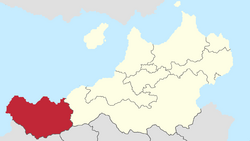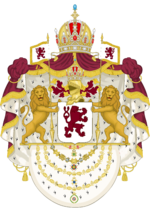Ruttland: Difference between revisions
Britbong64 (talk | contribs) |
Britbong64 (talk | contribs) No edit summary |
||
| Line 21: | Line 21: | ||
| established_title = Annexation into Werania | | established_title = Annexation into Werania | ||
| established_date = 1850 | | established_date = 1850 | ||
| established_title1 = | | established_title1 = Free State | ||
| established_date1 = 1986 | | established_date1 = 1986 | ||
| established_title2 = | | established_title2 = | ||
| Line 80: | Line 80: | ||
The '''Free State of Ruttland''' (''{{wp|Lithuanian language|Ruttish}}'': '''Nemokama Ruttųijos Valstybė''') is a {{wp|constituent state}} within the [[Werania|Weranian Confederation]]. It borders [[Cislania]] to the east and has an international border with [[Kirenia]] to the west. It has a population of 10,792,847 and its capital is [[Lipliškės]] whilst its largest city is [[Šilokrautė]]. | The '''Free State of Ruttland''' (''{{wp|Lithuanian language|Ruttish}}'': '''Nemokama Ruttųijos Valstybė''') is a {{wp|constituent state}} within the [[Werania|Weranian Confederation]]. It borders [[Cislania]] to the east and has an international border with [[Kirenia]] to the west. It has a population of 10,792,847 and its capital is [[Lipliškės]] whilst its largest city is [[Šilokrautė]]. | ||
The presence of Ruttish people in the area dates back to the 3rd millennium BC. Under the Solarians Ruttish tribes were never | The presence of Ruttish people in the area dates back to the 3rd millennium BC. Under the Solarians Ruttish tribes were never conquered rather existing as tribal, pagan societies that were not united under any single authority. In the 1000's Ruttland was united under the [[Kingdom of Ruttland]] which existed as one of the last major pagan sites in Euclea across both parts of modern day Werania and Kirenia. In 1254 King [[Wilhelm I, Rudolphine Emperor|Vilimas I]] defeated the Rudolphine Confederation becoming its Emperor, but his dynasty would prove short lived. Parts of Ruttland would subsequently ruled both by the Kirenian Maritime League and Gallic [[Third North Sea Empire|North Sea Empire]]. | ||
Ruttland continued to exist within the confederation as its most important non-Weranic member, even maintaining a small {{wp|colonial empire}}, [[Aucuria]]. Fiscal mismanagement, governmental instability | Ruttland continued to exist within the confederation as its most important non-Weranic member, even maintaining a small {{wp|colonial empire}}, [[Aucuria]]. Fiscal mismanagement, and governmental instability weakened Ruttland over the 1700's. During the [[Ten Years' War]] Ruttland was one of the leaders of the anti-[[Cislania]] coalition but ultimately lost the war being annexed into [[Kirenia]]. Under Kirenian war Ruttland became one of the wealthier parts of the nation with a distinct Rutto-Kirenian culture emerging as a result. | ||
After the [[War of the Triple Alliance]] the province of Ruttland ceded to [[Werania]] where it became the | After the [[War of the Triple Alliance]] the province of Ruttland ceded to [[Werania]] where it became the Kingdom of Ruttland which was in personal union with the Kingdom of Cislania, the main component of the Weranic state. Ruttland was ruled in an authoritarian manner in a period known as "Reichsstatthalter rule" which saw a programme of {{Wp|Germanisation|Weranicisation}} being carried out. This ignited the [[Ruttish national revival]] which at first attempted to secede Werania in the [[Jurgaitytė rebellion]] before focusing on {{wp|cultural nationalism}} and attempting to achieve autonomy. An unrepresentative voting system that benefited ethnic Weranics compounded this sentiment, making the "Ruttish question" one of the defining political issues of the 1800's and early 1900's in Werania. | ||
Famed historically for its large steel industry, since {{Wp|deindustrilisation}} Ruttland has suffered from higher unemployment and lower living standards than the rest of Werania. Ruttland has however undergone a cultural revival in recent years with its | During the [[Great War (Kylaris)|Great War]] Ruttland was the site of the collaborationist [[Ruttish Republic]]. Following the war the Weranic dominated {{Wp|landtag}} was dissolved being replaced with the [[Seimas (Ruttland)|seimas]] which subsequently implemented policies reversing Weranicisation instead emphasising religious conservatism to combat left-wing ideologies. The [[Kirenian-Ruttish War]] saw Ruttland lose the majority Weranian Zinngebirge Basin making the region more homogenous Ruttish as a result. The province would continue to agitate for a strong regional identity leading to in 1986 a successful push by the central government to devolve more power to the region and formally end the monarchy in Ruttland, with the province becoming a free state. | ||
Famed historically for its large steel industry, since {{Wp|deindustrilisation}} Ruttland has suffered from higher unemployment and lower living standards than the rest of Werania. Ruttland has however undergone a cultural revival in recent years with its largest city Šilokrautė being considered one of the most vibrant cities in the country. | |||
==History== | ==History== | ||
===Prehistory=== | ===Prehistory=== | ||
| Line 145: | Line 147: | ||
===Television=== | ===Television=== | ||
===Holidays=== | ===Holidays=== | ||
{{Template: | {{Template:Werania}} | ||
[[Category:Werania]] | [[Category:Werania]] | ||
Revision as of 01:00, 9 June 2021
Free State of Ruttland
| |
|---|---|
| Anthem: O, brangioji giraitės medis Oh dear rowan tree | |
 | |
| Country | Werania |
| Status | Free state within a federal monarchy |
| Annexation into Werania | 1850 |
| Free State | 1986 |
| Capital | Lipliškės |
| Government | |
| • Type | Devolved parliamentary republic in a federal monarchy |
| • Body | Seimas |
| • Minister-Chairman | Žygimantas Navikas |
| Population (2018) | |
| • Total | 10,792,847 |
| Demonym | Ruttish |
| GDP | |
| • Total | $399,140 million |
| • Per capita | $36,981 |
| Area code | +893 |
| Official languages | Ruttish Weranic |
The Free State of Ruttland (Ruttish: Nemokama Ruttųijos Valstybė) is a constituent state within the Weranian Confederation. It borders Cislania to the east and has an international border with Kirenia to the west. It has a population of 10,792,847 and its capital is Lipliškės whilst its largest city is Šilokrautė.
The presence of Ruttish people in the area dates back to the 3rd millennium BC. Under the Solarians Ruttish tribes were never conquered rather existing as tribal, pagan societies that were not united under any single authority. In the 1000's Ruttland was united under the Kingdom of Ruttland which existed as one of the last major pagan sites in Euclea across both parts of modern day Werania and Kirenia. In 1254 King Vilimas I defeated the Rudolphine Confederation becoming its Emperor, but his dynasty would prove short lived. Parts of Ruttland would subsequently ruled both by the Kirenian Maritime League and Gallic North Sea Empire.
Ruttland continued to exist within the confederation as its most important non-Weranic member, even maintaining a small colonial empire, Aucuria. Fiscal mismanagement, and governmental instability weakened Ruttland over the 1700's. During the Ten Years' War Ruttland was one of the leaders of the anti-Cislania coalition but ultimately lost the war being annexed into Kirenia. Under Kirenian war Ruttland became one of the wealthier parts of the nation with a distinct Rutto-Kirenian culture emerging as a result.
After the War of the Triple Alliance the province of Ruttland ceded to Werania where it became the Kingdom of Ruttland which was in personal union with the Kingdom of Cislania, the main component of the Weranic state. Ruttland was ruled in an authoritarian manner in a period known as "Reichsstatthalter rule" which saw a programme of Weranicisation being carried out. This ignited the Ruttish national revival which at first attempted to secede Werania in the Jurgaitytė rebellion before focusing on cultural nationalism and attempting to achieve autonomy. An unrepresentative voting system that benefited ethnic Weranics compounded this sentiment, making the "Ruttish question" one of the defining political issues of the 1800's and early 1900's in Werania.
During the Great War Ruttland was the site of the collaborationist Ruttish Republic. Following the war the Weranic dominated landtag was dissolved being replaced with the seimas which subsequently implemented policies reversing Weranicisation instead emphasising religious conservatism to combat left-wing ideologies. The Kirenian-Ruttish War saw Ruttland lose the majority Weranian Zinngebirge Basin making the region more homogenous Ruttish as a result. The province would continue to agitate for a strong regional identity leading to in 1986 a successful push by the central government to devolve more power to the region and formally end the monarchy in Ruttland, with the province becoming a free state.
Famed historically for its large steel industry, since deindustrilisation Ruttland has suffered from higher unemployment and lower living standards than the rest of Werania. Ruttland has however undergone a cultural revival in recent years with its largest city Šilokrautė being considered one of the most vibrant cities in the country.
History
Prehistory
Early history
Middle Ages
Annexation in Sunrosia
Imperial era
Post-war history
Government and Politics
Government
Legislature
 |
|
RSDT: 7 seats Greens: 9 seats SDRP-DS: 12 seats NNK: 70 seats SDT: 16 seats NKP: 11 seats |




